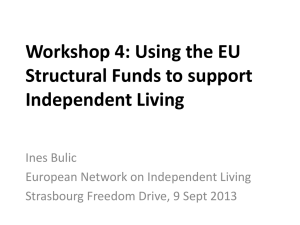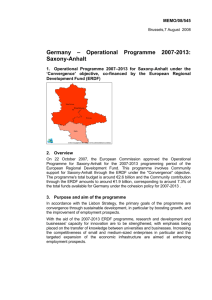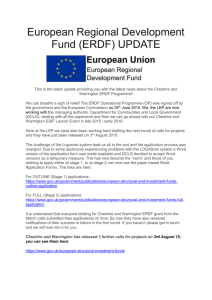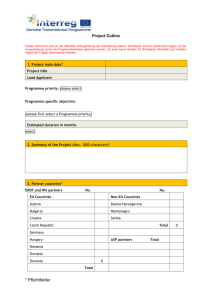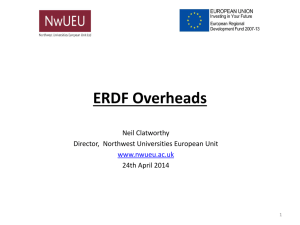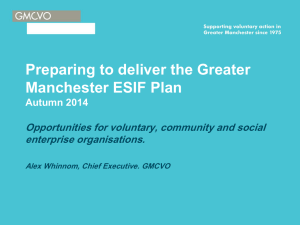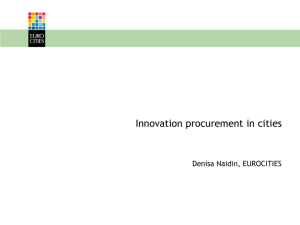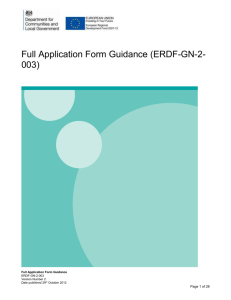draft chapter 6 – private sector infrastructure projects
advertisement
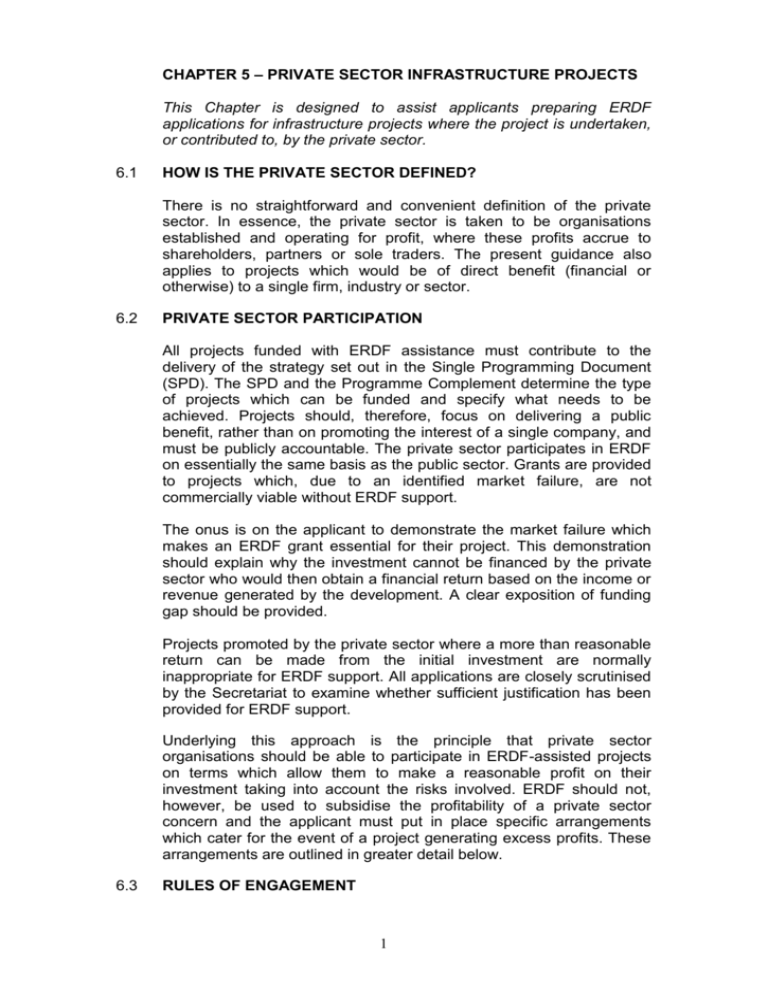
CHAPTER 5 – PRIVATE SECTOR INFRASTRUCTURE PROJECTS This Chapter is designed to assist applicants preparing ERDF applications for infrastructure projects where the project is undertaken, or contributed to, by the private sector. 6.1 HOW IS THE PRIVATE SECTOR DEFINED? There is no straightforward and convenient definition of the private sector. In essence, the private sector is taken to be organisations established and operating for profit, where these profits accrue to shareholders, partners or sole traders. The present guidance also applies to projects which would be of direct benefit (financial or otherwise) to a single firm, industry or sector. 6.2 PRIVATE SECTOR PARTICIPATION All projects funded with ERDF assistance must contribute to the delivery of the strategy set out in the Single Programming Document (SPD). The SPD and the Programme Complement determine the type of projects which can be funded and specify what needs to be achieved. Projects should, therefore, focus on delivering a public benefit, rather than on promoting the interest of a single company, and must be publicly accountable. The private sector participates in ERDF on essentially the same basis as the public sector. Grants are provided to projects which, due to an identified market failure, are not commercially viable without ERDF support. The onus is on the applicant to demonstrate the market failure which makes an ERDF grant essential for their project. This demonstration should explain why the investment cannot be financed by the private sector who would then obtain a financial return based on the income or revenue generated by the development. A clear exposition of funding gap should be provided. Projects promoted by the private sector where a more than reasonable return can be made from the initial investment are normally inappropriate for ERDF support. All applications are closely scrutinised by the Secretariat to examine whether sufficient justification has been provided for ERDF support. Underlying this approach is the principle that private sector organisations should be able to participate in ERDF-assisted projects on terms which allow them to make a reasonable profit on their investment taking into account the risks involved. ERDF should not, however, be used to subsidise the profitability of a private sector concern and the applicant must put in place specific arrangements which cater for the event of a project generating excess profits. These arrangements are outlined in greater detail below. 6.3 RULES OF ENGAGEMENT 1 The private sector plays a vital part in the delivery of the programme partly by contributing financially to projects conceived and led by local authorities and other public bodies. Since ERDF assisted projects must contribute to the economic benefit of the programme, most infrastructure projects will have some public sector involvement. Therefore, private sector applicants are unlikely to be successful without the involvement of a local authority or other public body. The public and private sectors should share the risks involved in a project according to their financial contribution and potential returns. However, the public sector contribution should not be used as a means of offsetting the commercial risk of the investment. Wherever possible the choice of private sector partners in projects conceived by public bodies should be competitive. The project should have a "primary recipient” who will submit the application, and receive and be accountable for the grant. The primary recipient will normally be a public body, as this demonstrates the public interest and helps to ensure that public benefits are achieved. A public body acting as primary recipient need not necessarily be the project leader, but it should contribute at least 5% of the eligible project costs. If a private sector partner cannot secure a public body as primary recipient, it should consult the Secretariat. A private sector organisation should apply direct for ERDF only if the lack of a public sector partner can be justified. It should be able to provide a report by an independent auditor certifying that it has clear and reliable internal procedures for monitoring the financial and physical progress of the project. As a general rule, all ERDF applications should be sponsored by a public sector partner, who will act as the primary recipient and be accountable for the delivery of the outputs. The public sector partner should provide a minimum financial contribution of 5% of the eligible costs. Only in circumstances where the lack of a public sector lead partner can be fully explained and justified, is it possible for a private sector organisation to apply directly. Where the majority of co-financing is being provided by the private sector, but the project is being sponsored by a public sector partner, it is the responsibility of the lead public organisation to ensure the effective delivery of the project. The public sector is accountable to the Secretariat for the achievement of the outputs and impacts agreed in the approved application, irrespective of the fact that they may only be providing a minimum 5% contribution to eligible costs. It is in the interests of the public sector, therefore, to ensure that sufficiently robust legal agreements have been entered into with their private sector partners on a project. As outlined above, in the event of 2 problems on a project, it is the public sector lead applicant who will be held accountable to the Secretariat for the delivery of the outputs. In the event of a project substantially under-achieving against the outputs agreed in the application, some or all of the approved ERDF grant may be required to be repaid. Where a public-private partnership is established for the purposes of an ERDF project, the public sector applicant is wholly accountable for the delivery of the outputs, irrespective of the fact that the private sector partner may be providing the vast majority of the co-financing. It is the responsibility of the public sector sponsor to ensure that the necessary agreements are in place with their private sector partners. 6.4 MAKING APPLICATIONS In order to establish an early dialogue with the Secretariat, and to establish the eligibility of and detail required in the final application, project promoters are encouraged to complete and submit an outline application form before embarking on further, perhaps costly, work. Copies of this form are available from the Secretariat. Applications involving private sector partners will need to: contain all the information required by the ERDF application form so that the Secretariat can make the assessments set out below; demonstrate how the proposed project will meet the objectives and achieve the outputs set out in the SPD and the Programme Complement; and include a market evaluation and financial appraisal which demonstrates why the proposal is not commercially viable without structural funds support Before an offer letter is issued, applicants will need to satisfy all necessary legislative requirements relevant to their proposal, for example, obtaining planning approvals. For larger schemes, it is the responsibility of applicants to present a properly constructed and independent economic appraisal of their proposals, to justify the level of ERDF sought. In considering applications, the Secretariat will call on independent specialists to agree land values, appropriate profit levels, prospects of achieving anticipated rents, and the potential yield. Calculating Grant Applications should be for the minimum ERDF grant necessary to make the project viable. The Secretariat can advise on ERDF grant rates available for different types of projects. Capital projects undertaken in partnership with a profit distributing private company may attract no more than 35% of eligible costs if the company would obtain commercial benefits as a direct result of the ERDF subsidy. Eligible capital costs include land acquisition (normally no more than 3 10% of total grant), site investigation, clearance and preparation, construction works, and associated fees. Further information on eligible costs for ERDF projects is provided in Chapter 2. For ERDF purposes, profit is not treated as a cost, although it is taken into account in calculating the minimum grant necessary. One way of assessing the amount of grant required is by using a “gap funding" calculation. This compares the total cost of a project (allowing for a reasonable profit) with its value on completion. Depending on the nature of the project, the value would most likely be based on capitalised rent. Grant is calculated against eligible costs with the intention of bridging the gap between cost and value. Alternatively, a discounted cash flow method could be applied, although in practice such an approach for property projects is unusual. Grant will normally be paid in agreed stages against claims for certified costs defrayed, for example in the construction phase of the project. An independent audit of projects will be required annually. Applicants are encouraged to adopt an open book approach. Financial Controls - Clawback As outlined above, a condition of an ERDF approval is that the applicant puts in place appropriate arrangements for the repayment of grant, to cater for the event of the project generating excess profits. Projects are permitted to generate a reasonable return based on the risk involved; profit over and above this agreed level is, however, deemed to be excessive. There is no specific guidance on what is defined as reasonable profit - each application is treated on a case by case basis If actual profit exceeds that agreed during project appraisal, grant may be reclaimed, or “clawed-back” in proportion to the level of grant awarded. For instance, if the ERDF rate was 20%, 20% of excess profits will be assessed (normally two years after completion) and compared with the value assumed in the appraisal. If the actual value is higher than anticipated, the clawback clause would come into effect. As an alternative to recovering grant the Secretariat may allow project participants to invest an equivalent amount in further projects which promote the aims of the relevant programme. Repayment of grant may be required for other reasons explained in the grant offer letter, e.g. if the use of the project changes, or if assets are sold and this was not agreed during project appraisal. The European Commission also has powers to reduce or suspend grant, if project outputs are not being delivered. Further details are available from the Secretariat. 6.5 CONCLUSIONS The participation of the private sector in ERDF-supported infrastructure projects is governed by a detailed set of arrangements, designed to 4 ensure that ERDF monies support activities which achieve the wider economic development of the relevant programme area rather than merely provide benefits to an individual business. Organisations with a potential project application which involves substantial private sector involvement are encouraged to contact the Government Office at an early stage to discuss their proposals. The private sector can also access ERDF through delegated grant funds and repayable aid schemes details of which are explained in the annex on match funding. 5
